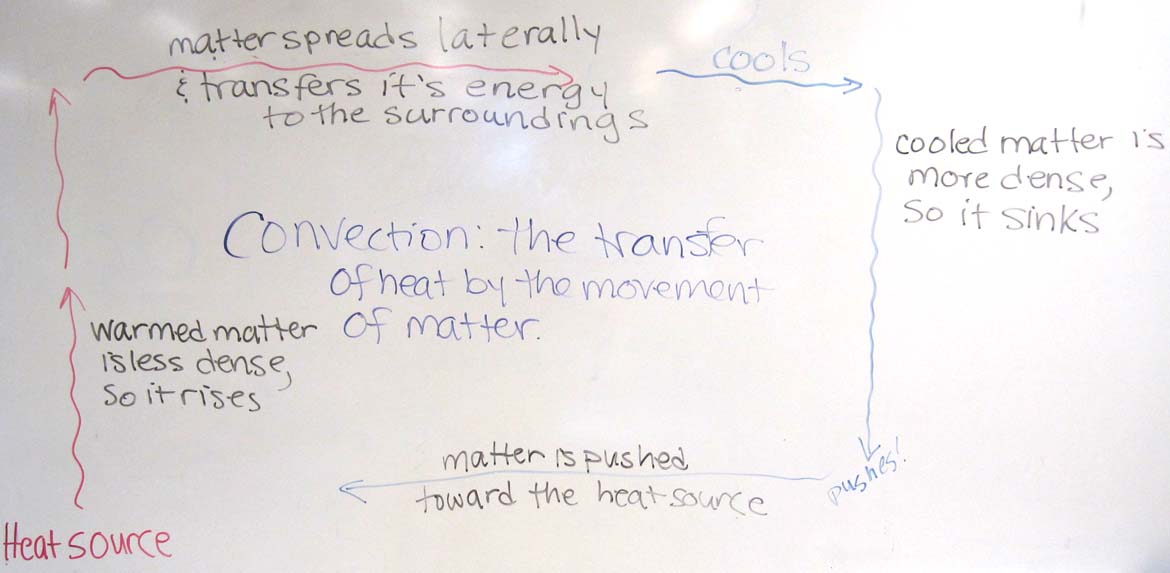Week 8: Fluid Circulation
This week's activities:
- Density Currents (p.174-181)
- Convection (p.182-189)
Density Currents
Density: mass/volume; dense: having parts crowded together; compact
In this activity, all the groups do the same basic investigation of different density fluids and then each group investigates one of three natural situations (using 6 groups each natural situation is done by 2 different groups). The investigations are on p.179-181. Specific background information about each natural situation is on p.174-177 - be sure to read through these.
Here is more information about deep water circulation:
Surface sea water sinks near the poles (near Greenland in the North Atlantic and in the Weddell Sea by Antarctica) because it is cold and extra salty there:
Water near the poles is cold! Cold water is more dense than warm water.
The Gulf Stream (a northbound ocean current that moves up the eastern seaboard of the United States) delivers salty water up to the North Atlantic (got saltier down in the subtropics where evaporation exceeds precipitation and then the Gulf Stream took it up to Greenland).
So not only is the water near Greenland ice cold, it is also extra salty - Cold salty water is very dense!
Please note that it is the presence of sea ice in the Weddell Sea in down in Antarctic that makes the water there extra salty. Salt cannot go into ice; so, it is driven into the water just below the ice making that ice extra salty. Once again - Cold salty water is very dense!
Deep waters (North Atlantic Deep Water from near Greenland) and Antarctic Bottom Waters (from the Weddell Sea by Antacrtica) circulate through the ocean basins, then are returned to the surface in ~1000 years. This is called the Global Conveyor Belt and it delivers cold salty oxygenated water do the deeper parts of the ocean (and also stores dissolved carbon dioxide down there too).
For more information about the conveyor belt and its link to climate change go to this link: http://science.nasa.gov/headlines/y2004/05mar_arctic.htmx
Because the water near the poles is sinking down, warm surface waters move in to replace that water - this makes the Gulf Stream (that surface current that brings relatively warm salty water up to the North Atlantic) move further north than it would normally. Because it does come so far north, this warm current is what makes the climate in northern Europe fairly mild. For a map showing the Gulf Stream, go to these links:
http://www.sott.net/image/s2/43662/full/gulf_stream.gif
http://oceancurrents.rsmas.miami.edu/atlantic/spaghetti-speed/gulf-stream.jpgMelting ice adds fresh water to the ocean, lowering its salinity. If too much fresh water enters the North Atlantic, its waters could stop sinking (if it isn't extra salty, then it won't be dense enough to sink). The Global Conveyor Belt would shut down and the heat-bearing Gulf Stream waters would no longer flow into the North Atlantic. Thus, European and North American winters would become more severe. Europe's average temperature would likely drop 5 to 10°C (9 to 18°F), and parts of eastern North America would be chilled somewhat less. Such a dip in temperature would be similar to global average temperatures toward the end of the last ice age roughly 20,000 years ago. In this way it is possible for global warming to actually lead Earth into another Ice Age! Studies show that cooling to ice age conditions takes a couple centuries. More rapid warming has occurred over decades.
Convection
This activity is self explanatory - hopefully you won't miss it. Read the background information on p.182-183.
Click here for a teacher's guide for convection (just read the backgroud part): http://www.ucar.edu/learn/1_1_2_7t.htm
Click here for an Educator's Guide to Convection: http://www.solarviews.com/eng/edu/convect.htm
Click here for the difference between convection, conduction, and radiation: http://www.mansfieldct.org/schools/mms/staff/hand/convcondrad.htm
If you miss week 8:
Read through these notes and look over the activities in your manual to get a feel for the material covered this week. Read the material in your manual for each activity with care so that you understand what you missed, talk to a classmate to find out more. Contact Dr. Munn to arrange to make up the quiz that you missed (this must be done sometime before the next class). Worksheets collected for this lab will be listed on the Lab Schedule page and must be turned within a week. Click here for the syllabus information about missing class. Worksheets collected for this lab will be listed on the Lab Schedule page and must be turned within a week. Here are more specifics about the worksheets that were collected:
• Natural Situations Worksheets (for the Density Currents Activity) - read through the Density Currents information (p.174-177) and look over the natural situation activities (p.179-181)
• Check Your Understanding: Convection - read through the Convection information (p.182-183) and look at this photo of the drawing I put on the board:
